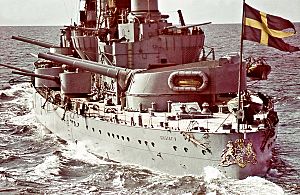Coat of arms of Sweden facts for kids
Quick facts for kids Greater coat of arms of the Kingdom of Sweden |
|
|---|---|
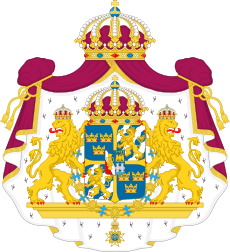 |
|
| Versions | |
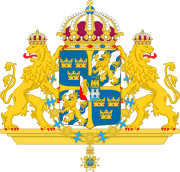
Version without the ermine mantling
|
|
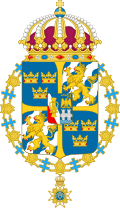
Version without the ermine mantling, the compartment and the supporters
|
|

Version consisting of the crowned escutcheon only
|
|
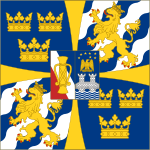
The banner of arms, which serves as a royal military command sign. Introduced by royal regulation in 1943, it has only been created once.
|
|
| Armiger | Carl XVI Gustaf The King of Sweden |
| Adopted | 1448 17 November 1905 |
| Crest | Royal Crown of Sweden |
| Blazon | Azure, quartered by a cross Or with outbent arms, and an inescutcheon containing the dynastic arms of the Royal House. In the first and fourth fields three open crowns Or, placed two above one. In the second and third fields three sinisterbendwise streams argent, a lion crowned with an open crown Or armed gules. The inescutcheon is party per pale the arms for the House of Vasa (Bendwise azure, argent and gules, a vasa (sheaf of wheat) Or); and the House of Bernadotte (Azure, issuant from a wavy base a bridge with three arches and two towers embattled argent, in honour point an eagle regardant with wings inverted resting on thunderbolts Or, and in chief the Big Dipper constellation of the same). |
| Supporters | two lions regardant, crowned and with forked tails (queue fourchée) Or armed gules, standing on a compartment Or |
| Compartment | Pedestal Or |
| Order(s) | Order of Seraphim |
| Other elements | All surrounded by ermine mantling, crowned with a royal crown and tied up with tasseladorned strings Or |
| Lesser coat of arms of the Kingdom of Sweden | |
|---|---|
 |
|
| Versions | |

Version without the Order of the Seraphim
|
|
| Armiger | The Riksdag Government of Sweden King of Sweden |
| Adopted | 1336 17 November 1905 |
| Crest | Royal Crown of Sweden |
| Blazon | Azure, three coronets Or, placed two above one |
| Order(s) | Order of the Seraphim |
The coat of arms of the Kingdom of Sweden (Swedish: Sveriges riksvapen) is a special symbol for the country. It has two main versions: a larger one and a smaller one. These symbols are very important and represent Sweden's history and its royal family.
Protecting Sweden's Symbols
The way Sweden's coats of arms are used is controlled by Swedish law. This law, called Act 1970:498, makes sure these symbols are not used improperly. For example, businesses cannot use the coats of arms or the flag in their trademarks without special permission.
This rule stops companies from making it seem like their products or services are officially approved by the Swedish government. Even symbols with three crowns, placed two above one, are considered the lesser coat of arms. Their use is also limited by this law.
Different Versions of the Arms
Sweden's coats of arms were first officially described by law in 1908. This law also clearly explained the differences between the "greater" and "lesser" arms. The current law that describes these two arms was made in 1982.
The Greater Coat of Arms
The greater coat of arms is the most detailed version. It is often used by the King and for very important national events.
What the Greater Arms Look Like
Imagine a blue shield with a gold cross on it. This cross has arms that bend outwards. In the middle of this main shield is a smaller shield. This smaller shield shows the special symbols of the royal family.
In the top left and bottom right sections of the main shield, there are three gold crowns. They are placed with two crowns on top and one below. In the other two sections, there are three wavy silver lines. On top of these lines is a gold lion wearing a crown. This lion has red claws.
The small shield in the middle is split down the middle. One side shows the symbols for the House of Vasa, an old royal family. The other side shows the symbols for the House of Bernadotte, which is the current royal family.
Royal Family Symbols
The Vasa symbol looks like a golden sheaf of wheat on a blue, silver, and red background. The Bernadotte symbol shows a silver bridge with three arches and two towers. It also has a golden eagle and the Big Dipper constellation.
The main shield is topped with a royal crown. It is also surrounded by the chain of the Royal Order of the Seraphim. This is Sweden's highest honor.
Lions and Mantling
Two lions stand on either side of the shield, supporting it. These lions wear crowns and have split tails. They are gold with red claws. They stand on a golden base.
The whole design is surrounded by a purple cloak, lined with white fur (ermine). This cloak is also topped with a royal crown and held with golden strings.
History of the Greater Arms
Even though the arms have changed over time, they are based on symbols created by King Karl Knutsson in 1448. The small shield in the middle changes to show the symbols of the family currently ruling.
The Big Dipper Symbol
The stars in the Bernadotte part of the shield were added in the 1800s. They were chosen to represent Sweden's eternal existence. A famous Swedish poet, Esaias Tegnér, wrote about the Big Dipper (which Swedes call Karlavagnen, or "Charles's Wain"). This symbol connects the royal family to Sweden's long history.
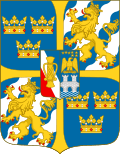 |
|||||||||||||||||||||
 The three crowns |
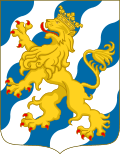 House of Bjelbo |
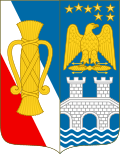 House of Bernadotte |
|||||||||||||||||||
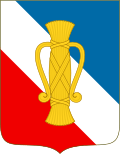 The House of Vasa |
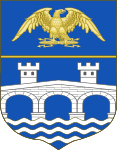 Arms of Jean Baptiste Jules Bernadotte as Prince of Ponte Corvo and Marshal of France (later Charles XIV of Sweden) |
||||||||||||||||||||
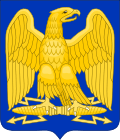 Napoleon I |
 Ponte Corvo |
||||||||||||||||||||
The greater coat of arms is the official national symbol. It is also the King's personal symbol. He can allow other members of the Royal House to use it, with changes he approves.
The Lesser Coat of Arms
The lesser coat of arms is a simpler version. It is mostly used by the Government of Sweden and other official Swedish groups.
Where the Lesser Arms Are Used
You can see this symbol on Swedish police uniforms. It is also on many coats of arms for the Swedish Armed Forces. You will find it on Sweden's passports and at Swedish embassies around the world.
What the Lesser Arms Look Like
The lesser coat of arms is a blue shield with three gold crowns. These crowns are placed with two on top and one below. This shield is topped with a royal crown. Sometimes, it can also be surrounded by the chain of the Royal Order of the Seraphim.
See also
 In Spanish: Escudo de Suecia para niños
In Spanish: Escudo de Suecia para niños
- Swedish heraldry
- Three Crowns
- Flag of Sweden
- List of flags of Sweden


